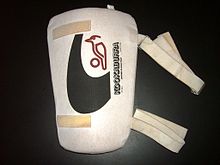

Collared shirt with short or long sleeves depending on the climate or personal preference. Long trousers (often white, but stained red in parts from polishing the ball) Jumper (a woollen pullover, if necessary). This is usually a vest. Jockstrap with cup pocket into which a "box", or protective cup, is inserted and held in place. Abdominal guard or "box" or an L Guard for male batsmen and wicket-keepers (often referred to as a cup, box or abdo guard). It is usually constructed from high density plastic with a padded edge, shaped like a hollow half-pear, and inserted into the jockstrap with cup pocket underwear of the batsmen and wicket-keeper. This is used to protect the genitals against impact from the ball. Sun hats, cricket cap or baseball cap Spiked shoes to increase traction .
Helmet (often with a visor), worn by batsmen and fielders close to the batsman on strike to protect their heads. Leg pads, worn by the two batsmen and the wicket-keeper, used to protect the shin bone against impact from the ball. The wicket-keeping pads are slightly different from the batsmen's. Fielders that are fielding in close to the batsmen may wear shin guards (internal) as well. Thigh guard, arm guards, chest guard, and elbow guards to protect the body of the batsmen. Gloves for batsmen only, thickly padded above the fingers and on the thumb of the hand, to protect against impact from the ball as it is bowled Wicket-keeper's gloves for the wicket-keeper. Usually includes webbing between the thumb and index fingers. Safety glasses, for wicket-keepers, to prevent damage to the eyes from dislodged bails impacting between the grill and peak of the helmet.


